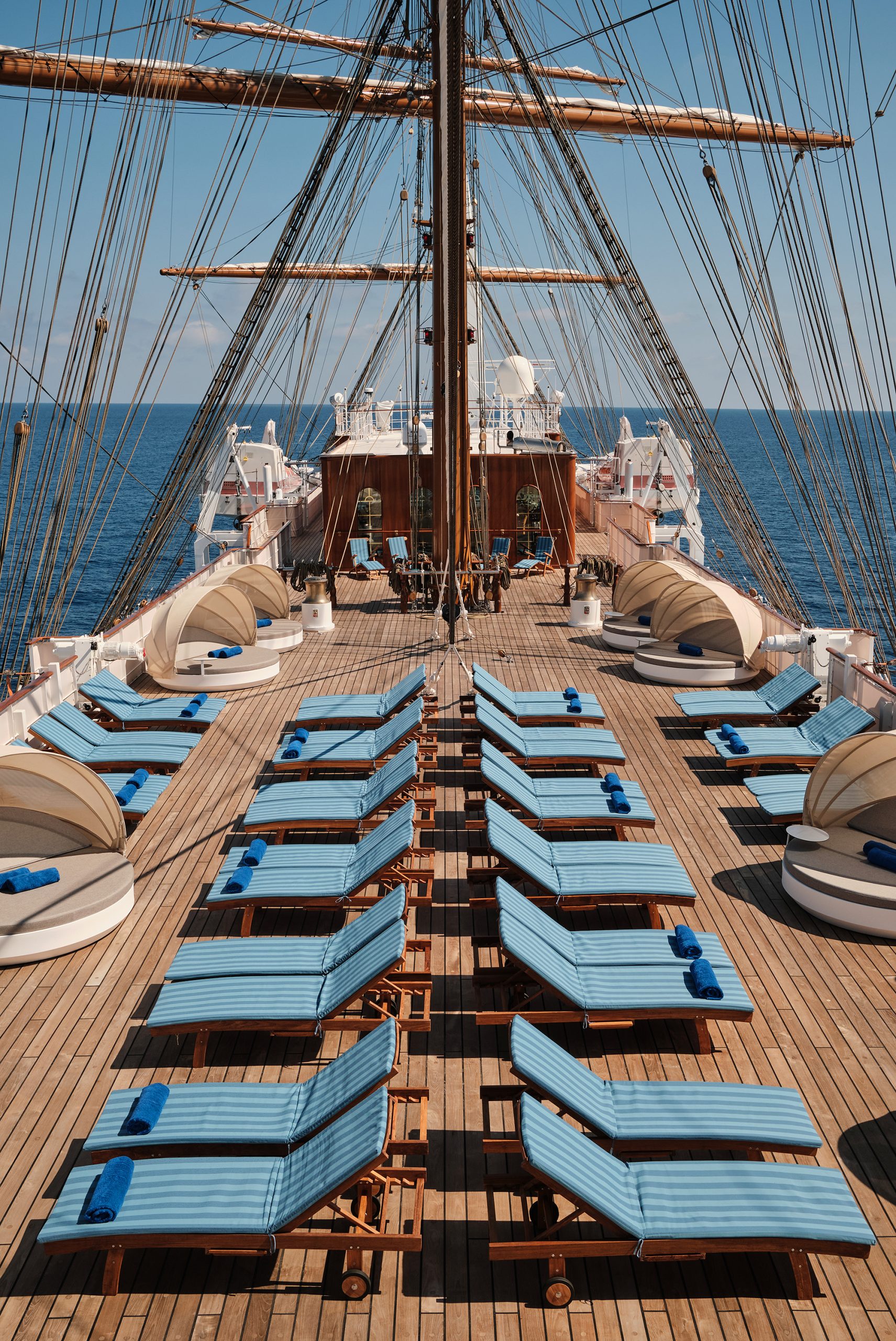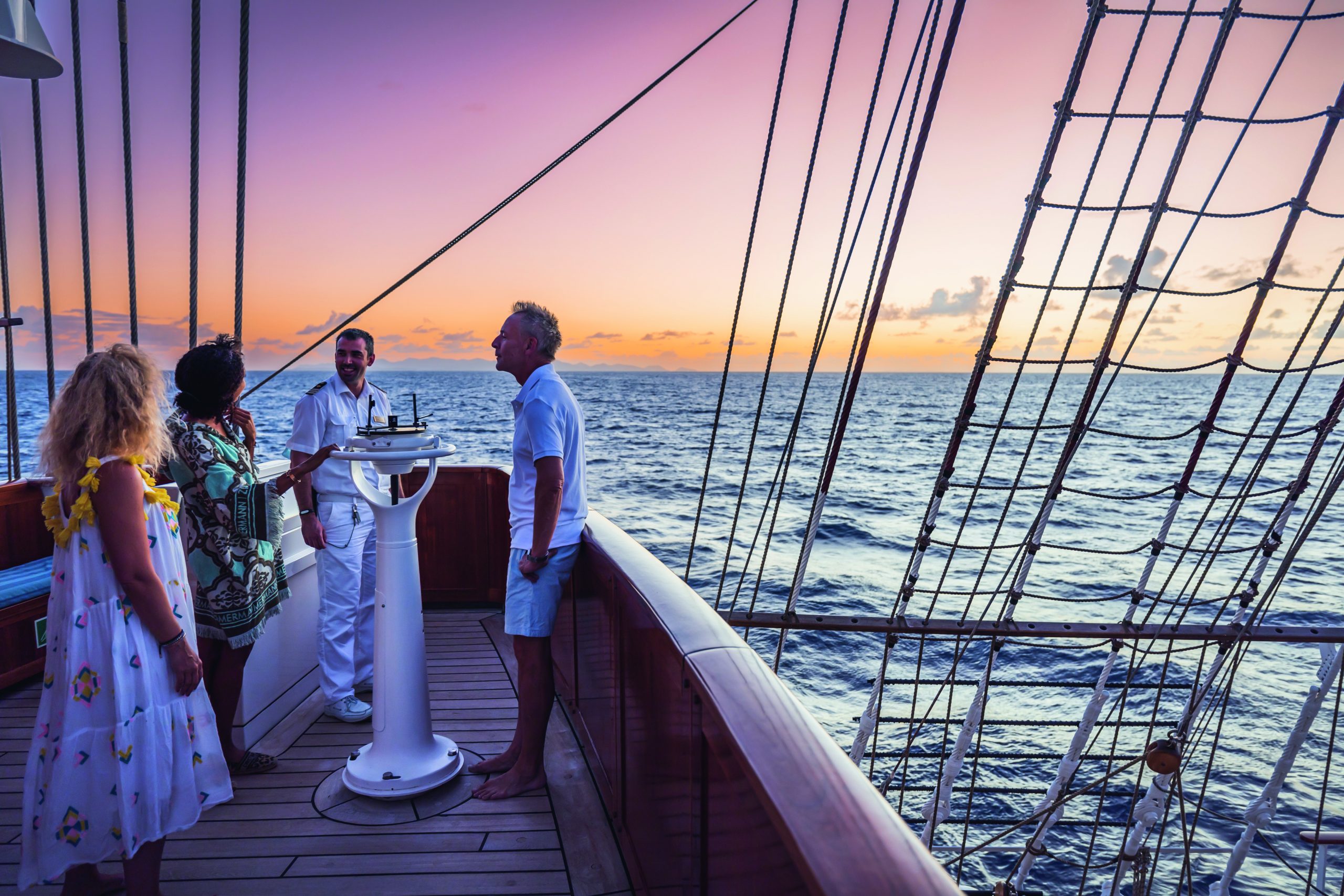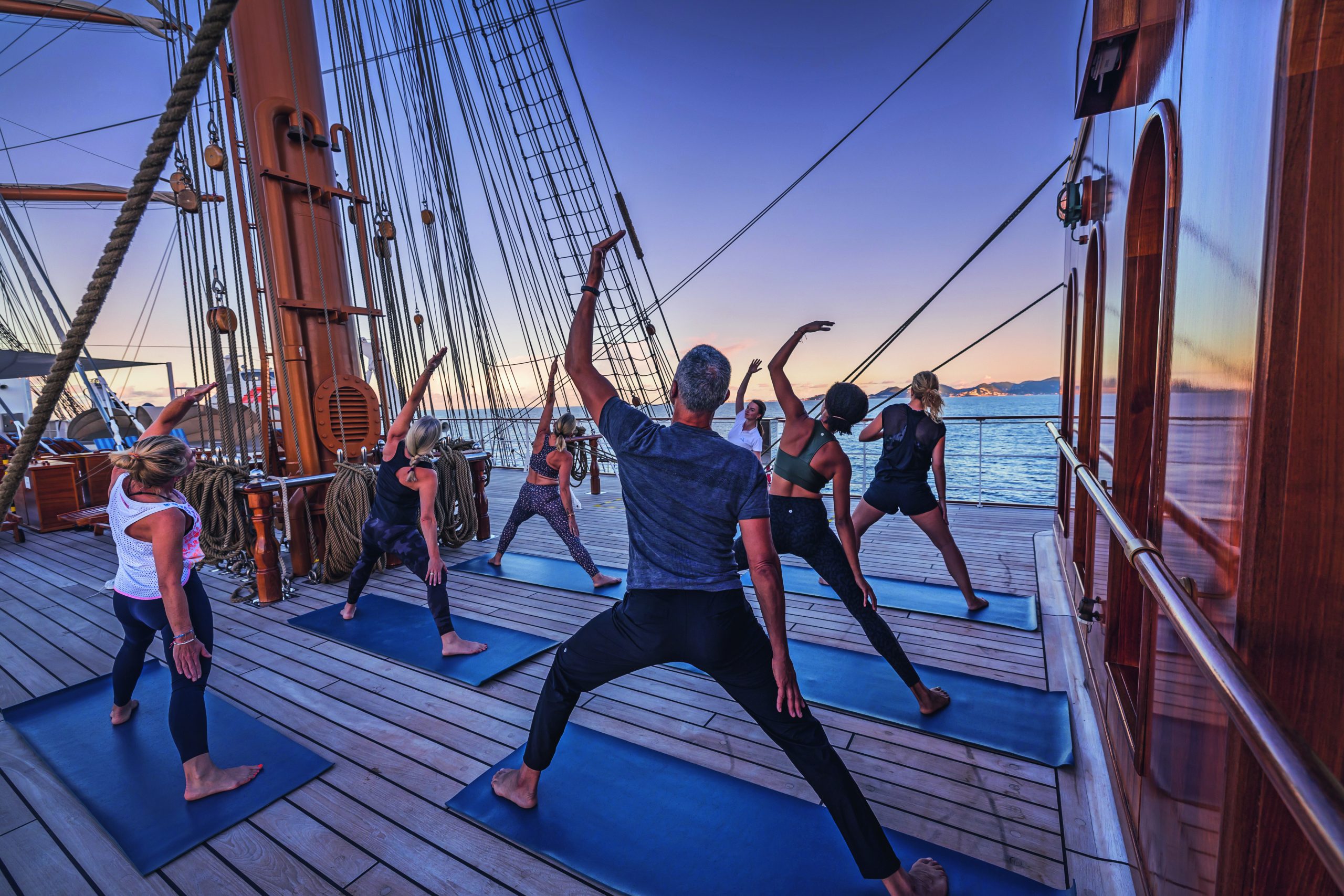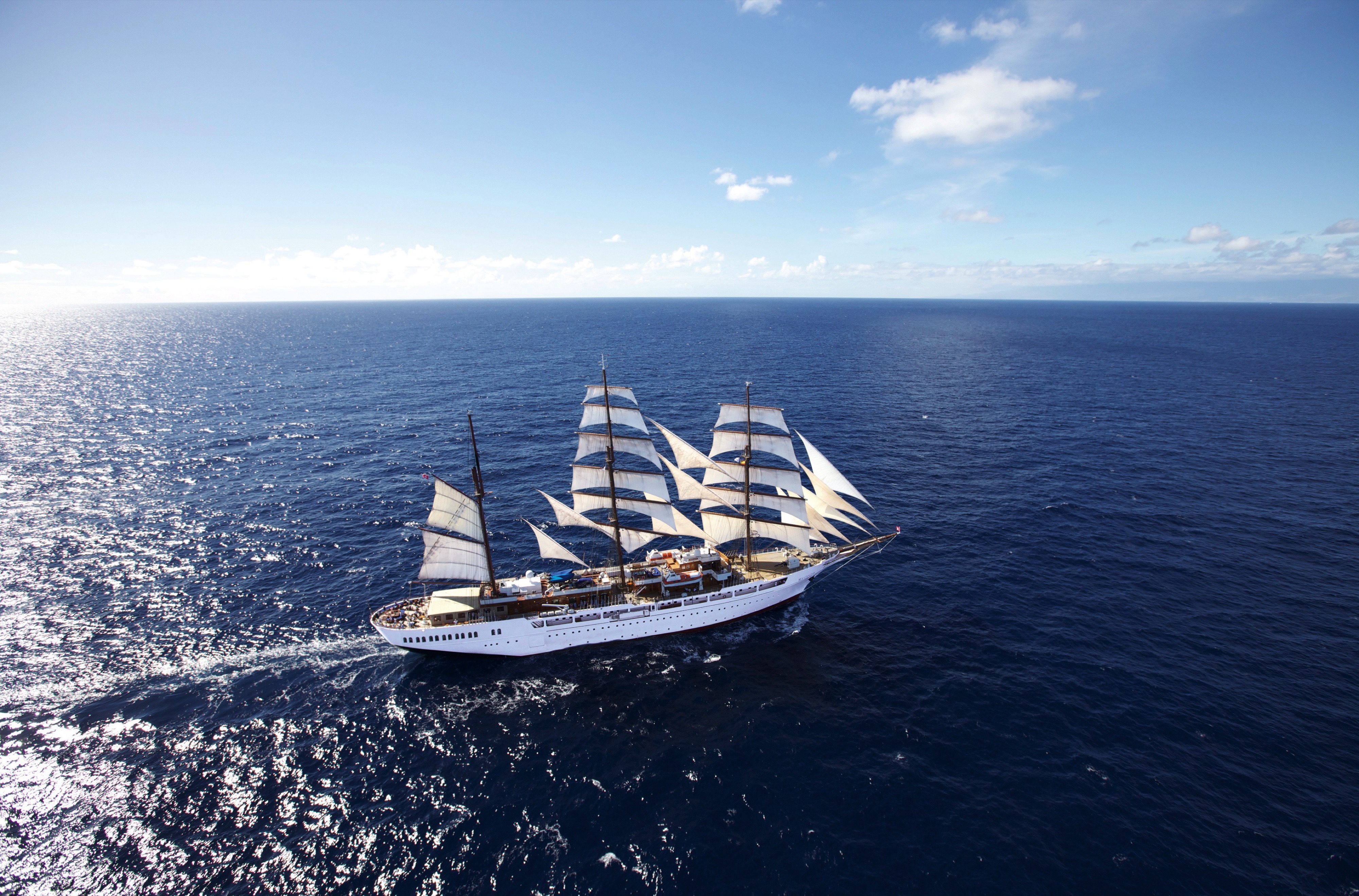Itinerary
Nothing can prepare you for your first sight of Dubrovnik. Lying 216 km (135 miles) southeast of Split and commanding a jaw-dropping coastal location, it is one of the world’s most beautiful fortified cities. Its massive stone ramparts and fortress towers curve around a tiny harbor, enclosing graduated ridges of sun-bleached orange-tiled roofs, copper domes, and elegant bell towers. Your imagination will run wild picturing what it looked like seven centuries ago when the walls were built, without any suburbs or highways around it, just this magnificent stone city rising out of the sea.In the 7th century AD, residents of the Roman city Epidaurum (now Cavtat) fled the Avars and Slavs of the north and founded a new settlement on a small rocky island, which they named Laus, and later Ragusa. On the mainland hillside opposite the island, the Slav settlement called Dubrovnik grew up. In the 12th century the narrow channel separating the two settlements was filled in (now the main street through the Old Town, called Stradun), and Ragusa and Dubrovnik became one. The city was surrounded by defensive walls during the 13th century, and these were reinforced with towers and bastions in the late 15th century.From 1358 to 1808 the city thrived as a powerful and remarkably sophisticated independent republic, reaching its golden age during the 16th century. In 1667 many of its splendid Gothic and Renaissance buildings were destroyed by an earthquake. The defensive walls survived the disaster, and the city was rebuilt in baroque style.Dubrovnik lost its independence to Napoléon in 1808, and in 1815 passed to Austria-Hungary. During the 20th century, as part of Yugoslavia, the city became a popular tourist destination, and in 1979 it was listed as a UNESCO World Heritage Site. During the war for independence, it came under heavy siege. Thanks to careful restoration, few traces of damage remain; however, there are maps inside the Pile and Ploče Gates illustrating the points around the city where damage was done. It’s only when you experience Dubrovnik yourself that you can understand what a treasure the world nearly lost
Nothing can prepare you for your first sight of Dubrovnik. Lying 216 km (135 miles) southeast of Split and commanding a jaw-dropping coastal location, it is one of the world’s most beautiful fortified cities. Its massive stone ramparts and fortress towers curve around a tiny harbor, enclosing graduated ridges of sun-bleached orange-tiled roofs, copper domes, and elegant bell towers. Your imagination will run wild picturing what it looked like seven centuries ago when the walls were built, without any suburbs or highways around it, just this magnificent stone city rising out of the sea.In the 7th century AD, residents of the Roman city Epidaurum (now Cavtat) fled the Avars and Slavs of the north and founded a new settlement on a small rocky island, which they named Laus, and later Ragusa. On the mainland hillside opposite the island, the Slav settlement called Dubrovnik grew up. In the 12th century the narrow channel separating the two settlements was filled in (now the main street through the Old Town, called Stradun), and Ragusa and Dubrovnik became one. The city was surrounded by defensive walls during the 13th century, and these were reinforced with towers and bastions in the late 15th century.From 1358 to 1808 the city thrived as a powerful and remarkably sophisticated independent republic, reaching its golden age during the 16th century. In 1667 many of its splendid Gothic and Renaissance buildings were destroyed by an earthquake. The defensive walls survived the disaster, and the city was rebuilt in baroque style.Dubrovnik lost its independence to Napoléon in 1808, and in 1815 passed to Austria-Hungary. During the 20th century, as part of Yugoslavia, the city became a popular tourist destination, and in 1979 it was listed as a UNESCO World Heritage Site. During the war for independence, it came under heavy siege. Thanks to careful restoration, few traces of damage remain; however, there are maps inside the Pile and Ploče Gates illustrating the points around the city where damage was done. It’s only when you experience Dubrovnik yourself that you can understand what a treasure the world nearly lost
Nothing can prepare you for your first sight of Dubrovnik. Lying 216 km (135 miles) southeast of Split and commanding a jaw-dropping coastal location, it is one of the world’s most beautiful fortified cities. Its massive stone ramparts and fortress towers curve around a tiny harbor, enclosing graduated ridges of sun-bleached orange-tiled roofs, copper domes, and elegant bell towers. Your imagination will run wild picturing what it looked like seven centuries ago when the walls were built, without any suburbs or highways around it, just this magnificent stone city rising out of the sea.In the 7th century AD, residents of the Roman city Epidaurum (now Cavtat) fled the Avars and Slavs of the north and founded a new settlement on a small rocky island, which they named Laus, and later Ragusa. On the mainland hillside opposite the island, the Slav settlement called Dubrovnik grew up. In the 12th century the narrow channel separating the two settlements was filled in (now the main street through the Old Town, called Stradun), and Ragusa and Dubrovnik became one. The city was surrounded by defensive walls during the 13th century, and these were reinforced with towers and bastions in the late 15th century.From 1358 to 1808 the city thrived as a powerful and remarkably sophisticated independent republic, reaching its golden age during the 16th century. In 1667 many of its splendid Gothic and Renaissance buildings were destroyed by an earthquake. The defensive walls survived the disaster, and the city was rebuilt in baroque style.Dubrovnik lost its independence to Napoléon in 1808, and in 1815 passed to Austria-Hungary. During the 20th century, as part of Yugoslavia, the city became a popular tourist destination, and in 1979 it was listed as a UNESCO World Heritage Site. During the war for independence, it came under heavy siege. Thanks to careful restoration, few traces of damage remain; however, there are maps inside the Pile and Ploče Gates illustrating the points around the city where damage was done. It’s only when you experience Dubrovnik yourself that you can understand what a treasure the world nearly lost
The Croatian island of Hvar bills itself as the “sunniest island in the Adriatic.” Not only does it have the figures to back up this claim—an annual average of 2,724 hours of sunshine—but it also makes visitors a sporting proposition, offering them a money-back guarantee if there are seven consecutive days of snow (snow has been known to fall here; the last time being February 2012).
The Croatian island of Hvar bills itself as the “sunniest island in the Adriatic.” Not only does it have the figures to back up this claim—an annual average of 2,724 hours of sunshine—but it also makes visitors a sporting proposition, offering them a money-back guarantee if there are seven consecutive days of snow (snow has been known to fall here; the last time being February 2012).
Off the coast of Croatia in the southern Adriatic Sea lie some thousand islands and the largest of them, Korçula, is considered the most beautiful. With an average of 3,000 hours of sunshine per annum, which guarantees a wide assortment of Mediterranean vegetation, it is not difficult to understand why seasoned travelers compare Korçula to a latter-day Eden. Separated from the mainland by a channel of only one mile, Korçula’s main town, named the same as the island, ranks among the best preserved medieval towns in the Mediterranean. It is the island’s main tourist, economic and cultural center. Thanks to its strategic location along the sea trade routes, Korçula has always attracted travelers and settlers. Korcula was founded by Greek colonists, who were followed by Illyrians, Romans and finally the Croats. The Korçula Statute of 1214 is one of the oldest legal documents to have been adopted in this part of Europe. The same century saw the birth of the famous world traveler, Marco Polo. The house said to be his birthplace can be seen in town. Korçulans have always been known as keen seafarers, excellent shipbuilders, stonemasons and artists. From their many voyages, sailors brought back new ideas, which eventually mixed with local customs. To this day, Korçula has maintained the tradition of performing knightly games such as the chivalrous Moreska dance, which has been in existence for more than 400 years. Visitors to Korçula enjoy its stunning location, natural beauty and medieval ambiance. And if that’s not enough, the town offers numerous attractions that are within walking distance from the pier, including the City Museum and the Bishop’s Treasury.
One of the true jewels of the Mediterranean, Rovinj is a jaw-droppingly beautiful town, which juts out into sparkling Mediterranean. Dominated by the pencil-like bell tower of the Venetian Saint Euphemia Cathedral, pine tree forests flow to the borders of the quaint Old Town – which evokes the romantic, tangled backstreets of the Venice. Rovinj – or Rovino in Italian – is a city of split personalities, with two official languages – having been owned by the Kingdom of Italy between 1919 and 1947.
Venice is a city unlike any other. No matter how often you’ve seen it in photos and films, the real thing is more dreamlike than you could imagine. With canals where streets should be, water shimmers everywhere. The fabulous palaces and churches reflect centuries of history in what was a wealthy trading center between Europe and the Orient. Getting lost in the narrow alleyways is a quintessential part of exploring Venice, but at some point you’ll almost surely end up in Piazza San Marco, where tourists and locals congregate for a coffee or an aperitif.
Ship features
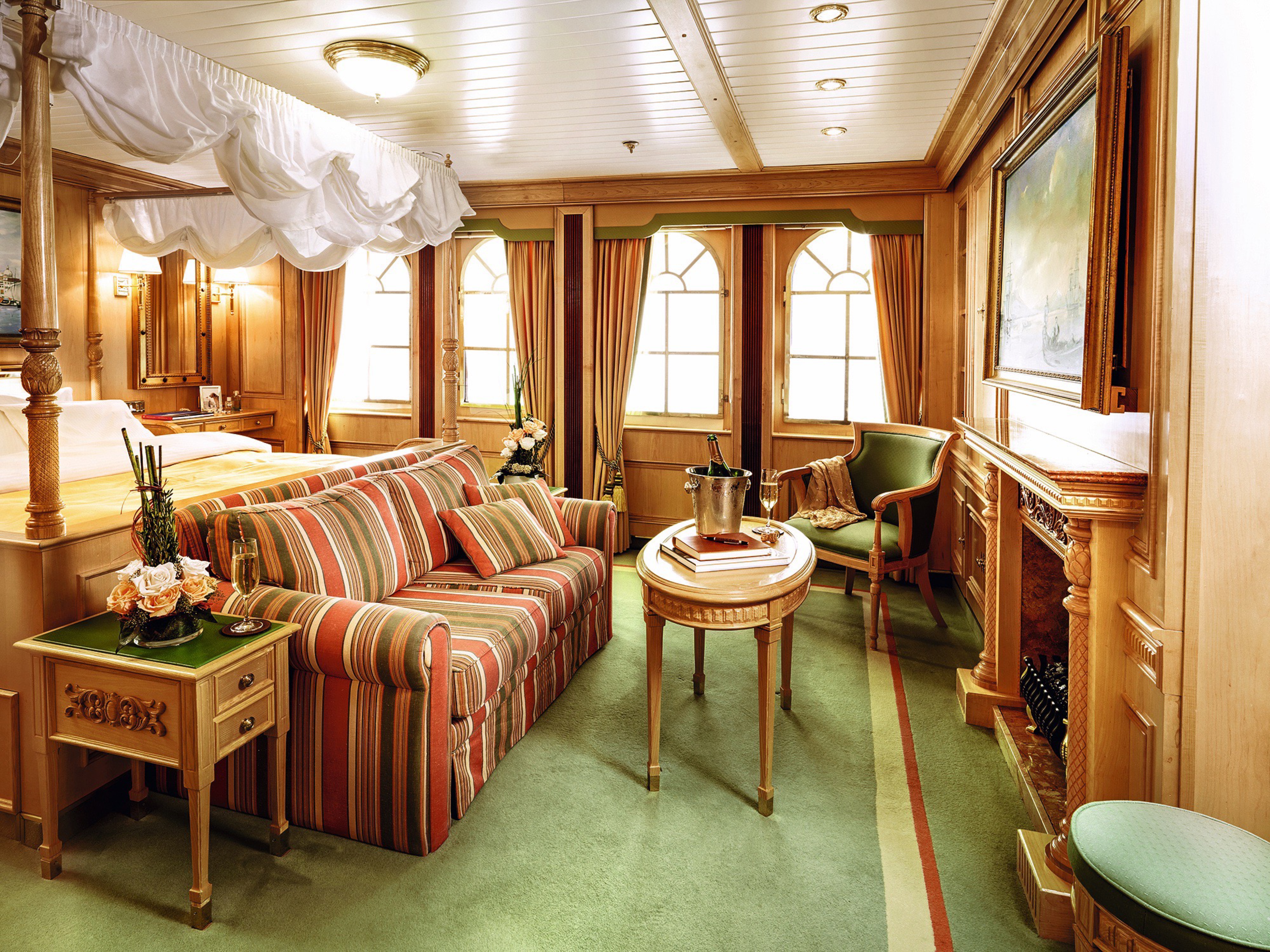
Luxury Owner Suites (Cat. A)
The two Owners’ Suites on SEA CLOUD II follow in the maritime spirit of always keeping exclusive quarters white-glove ready for the ship’s owners. Today, these luxury spaces are reserved for guests who appreciate the elevated side of sailing with the comforts of a private yacht. Both light-filled suites are located on the lido deck and feature panoramic windows for a unique view of the sea, even from the four-poster bed. The opulence includes a fireplace, elegant cabinetry, high-end furnishings, and a spacious marble bath outfitted in our legendary golden fixtures.
- approx. 290 sq. ft. / 27 m²
- marble bathroom approx. 45 sq. ft. / 4,2 m² with separate shower and bathtub
- canopy bed, 75 in. x 83 in. / 190 cm x 210 cm (2 mattresses)
- four closet spaces
- sofa with table
- fireplace (electric)
- minibar
- TV with DVD
- panoramic windows
- safe
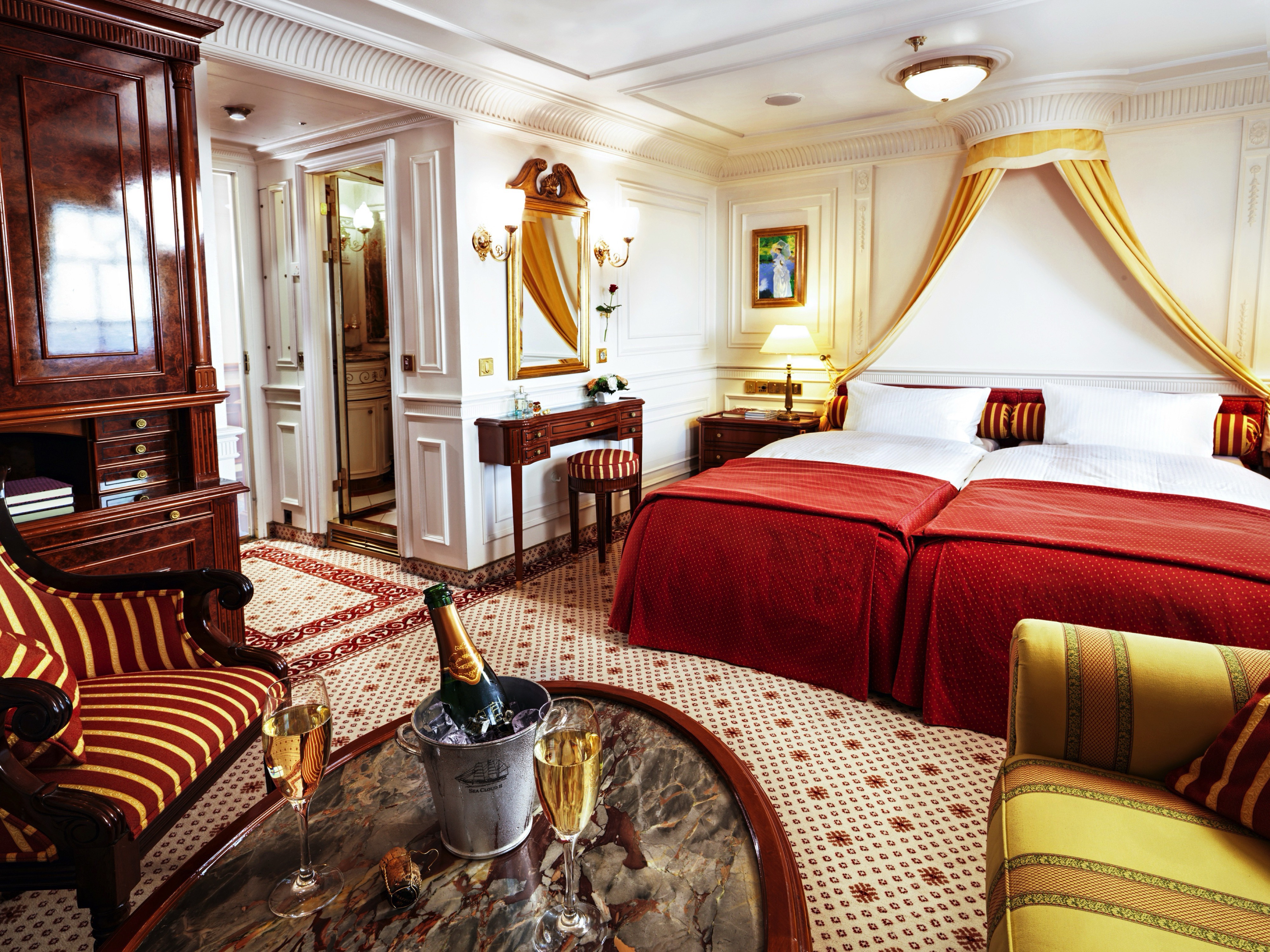
Junior Suites (Cat. B)
With rosewood furnishings, ornate wall finishings and a detailed marble fireplace, the junior suites are the epitome of luxury. Panoramic windows welcome in the sea, creating a bright, airy ambiance filled with casual elegance and upscale comfort. A separate sitting area makes the fireplace cosier. A majestic marble bath with golden fixtures is classic in this top tier. The Junior Suites are located on the promenade deck, with the restaurant, boutique, and reception close by.
- approx. 231 sq. ft. / 21,5 m²
- marble bathroom approx. 34 sq. ft. / 3,2 m² with shower and bathtub
- head-canopy bed, 71 in. x 79 in. / 180 cm x 200 cm (split king can be separated into 2 twins)
- walk-in closet
- sofa with table
- fireplace (electric)
- minibar
- TV with DVD
- panoramic windows
- safe
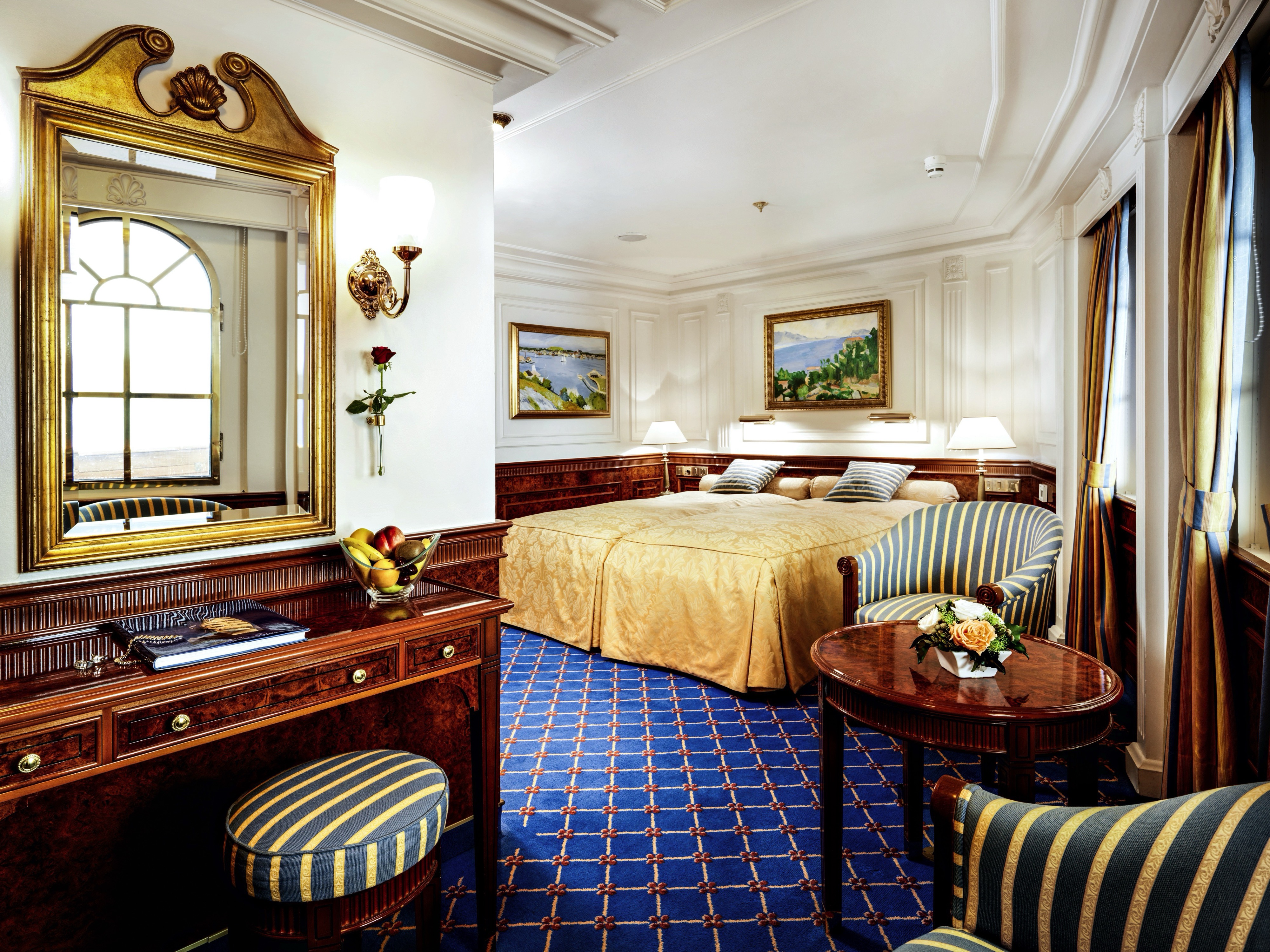
Grand Stateroom (Cat. C)
The two grand staterooms envelope guests in sophistication. While the design and decor are decidedly stately and classically maritime, they still offer ultimate comfort. Panoramic windows welcome expansive sea views. Their location in the front of the promenade deck follows the elegant line of the SEA CLOUD II, enhancing the exhilarating feeling of sailing on a private yacht.
- approx. 194 sq. ft. / 18 m²
- marble bathroom approx. 32 sq. ft. / 3 m² with shower, and golden fixtures
- double bed, 67 in. x 79 in. / 170 cm x 200 cm (2 mattresses)
- closet
- chair with table
- dressing table
- minibar
- TV with DVD
- panoramic windows
- safe

Deluxe Staterooms (Cat. D)
The three large porthole windows give these SEA CLOUD II deluxe staterooms a special maritime flair. With a luxurious yacht ambience, these upscale spaces magnify the feeling of being part of an extraordinary journey on an extraordinary ship. The spacious room exudes elevated coziness with sophisticated furnishing and finishings, a glamorous palette and a beautiful sitting area. The six deluxe staterooms are located mid-ship on the same deck as the massage and cosmetic treatments, fitness room, swim platform and hospital.
- approx. 226 sq. ft. / 21 m²
- marble bathroom approx. 32 sq. ft. / 3 m² with shower and golden fixtures
- double bed, 67 in. x 79 in. / 170 cm x 200 cm (2 mattresses)
- closet
- seating with table
- dressing table
- minibar
- •TV with DVD
- •three portholes
- •safe
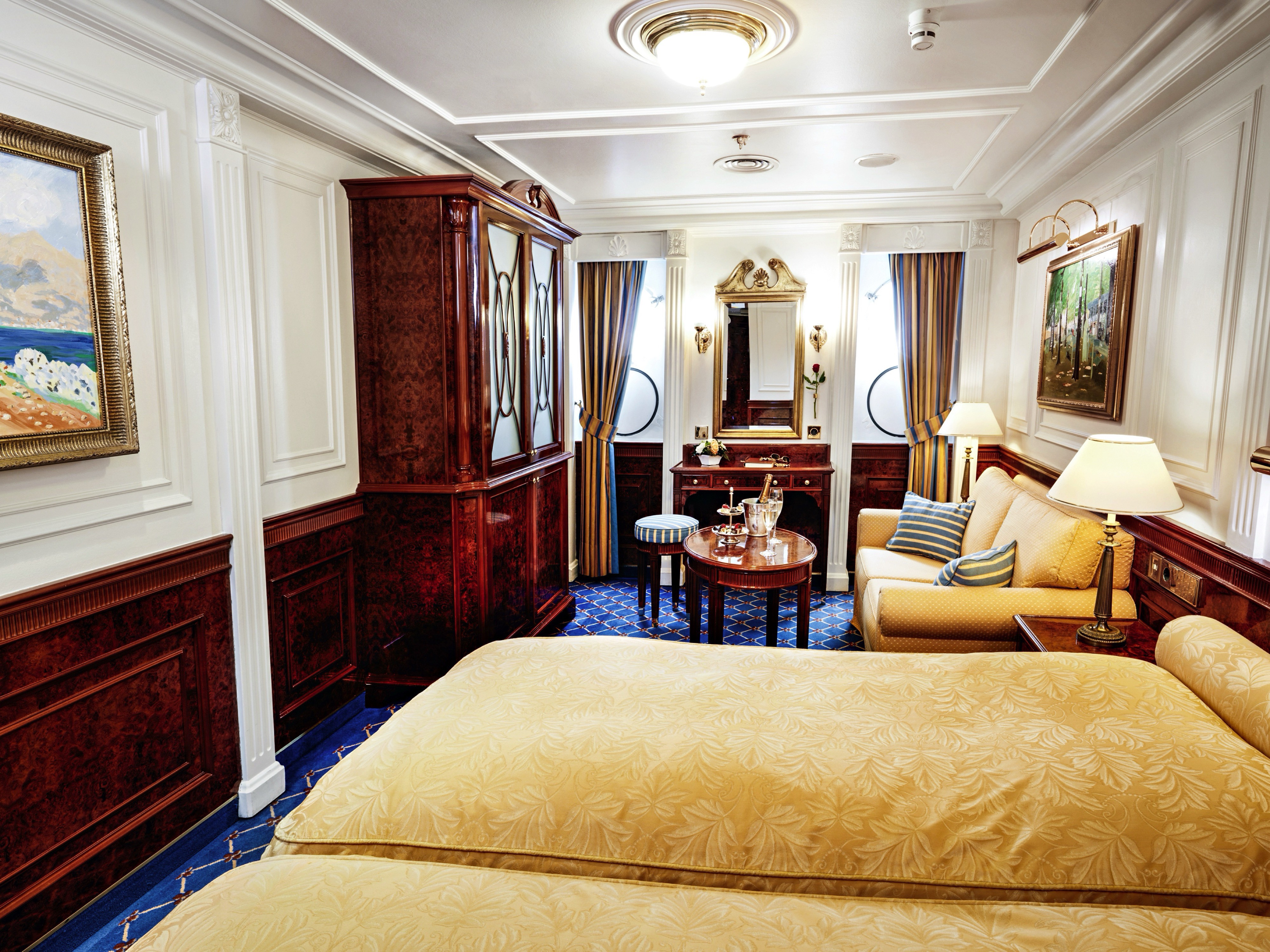
Deluxe Staterooms (Cat. E)
These outside deluxe staterooms with large porthole window are the epitome of nautical luxury on SEA CLOUD II. Located on both sides of the cabin deck, these are exclusive retreats of serenity that have made our sailing yachts famous. Sophisticated style comes in the form of rich wood finishings, Italian marble and golden fixtures.
- approx. 204 sq. ft. / 19 m²
- marble bathroom approx. 32 sq. ft. / 3 m² with shower and golden fixtures
- California king bed, 71 in. x 79 in. / 180 cm x 200 cm (split king can be separated into 2 twins)
- closet
- seating with table
- dressing table
- minibar
- TV with DVD
- two portholes
- safe
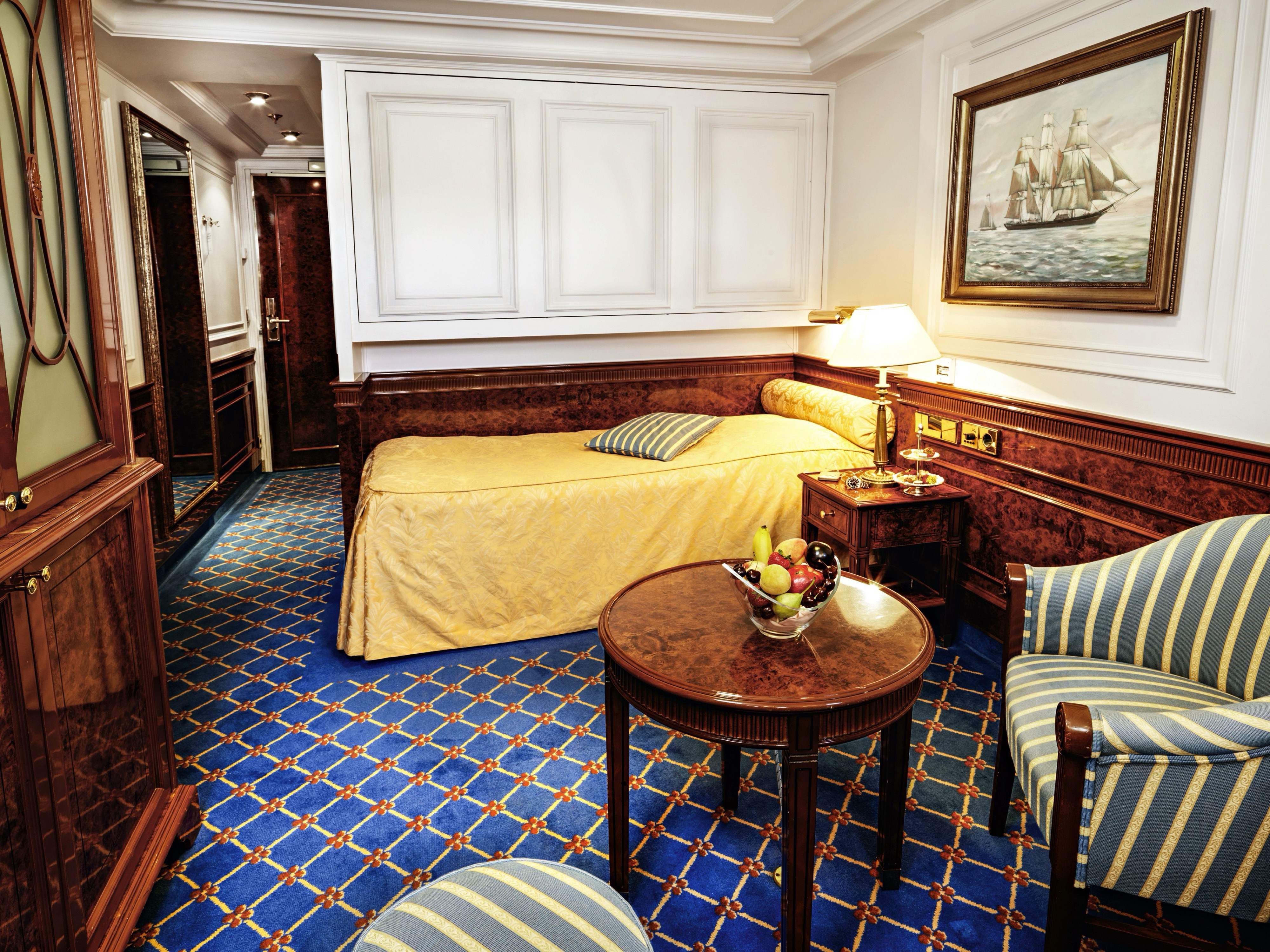
Cat. F Staterooms
These three outside staterooms with porthole windows spotlight a design inspired by officers’ cabins on traditional windjammers. Warm, lustrous woods and a comfortable sitting area exude a classically elegant maritime atmosphere and provide an elevated sanctuary at sea. They’re located on the same deck as massage and cosmetic treatments, the fitness room, swim platform and hospital.
- approx. 150 sq. ft. / 14 m²
- marble bathroom approx. 32 sq. ft. / 3 m² with shower and golden fixtures
- upper and lower beds, 32 in. x 75 in. / 80 cm x 190 cm
- closet
- chair with table
- dressing table
- minibar
- TV with DVD
- porthole
- safe
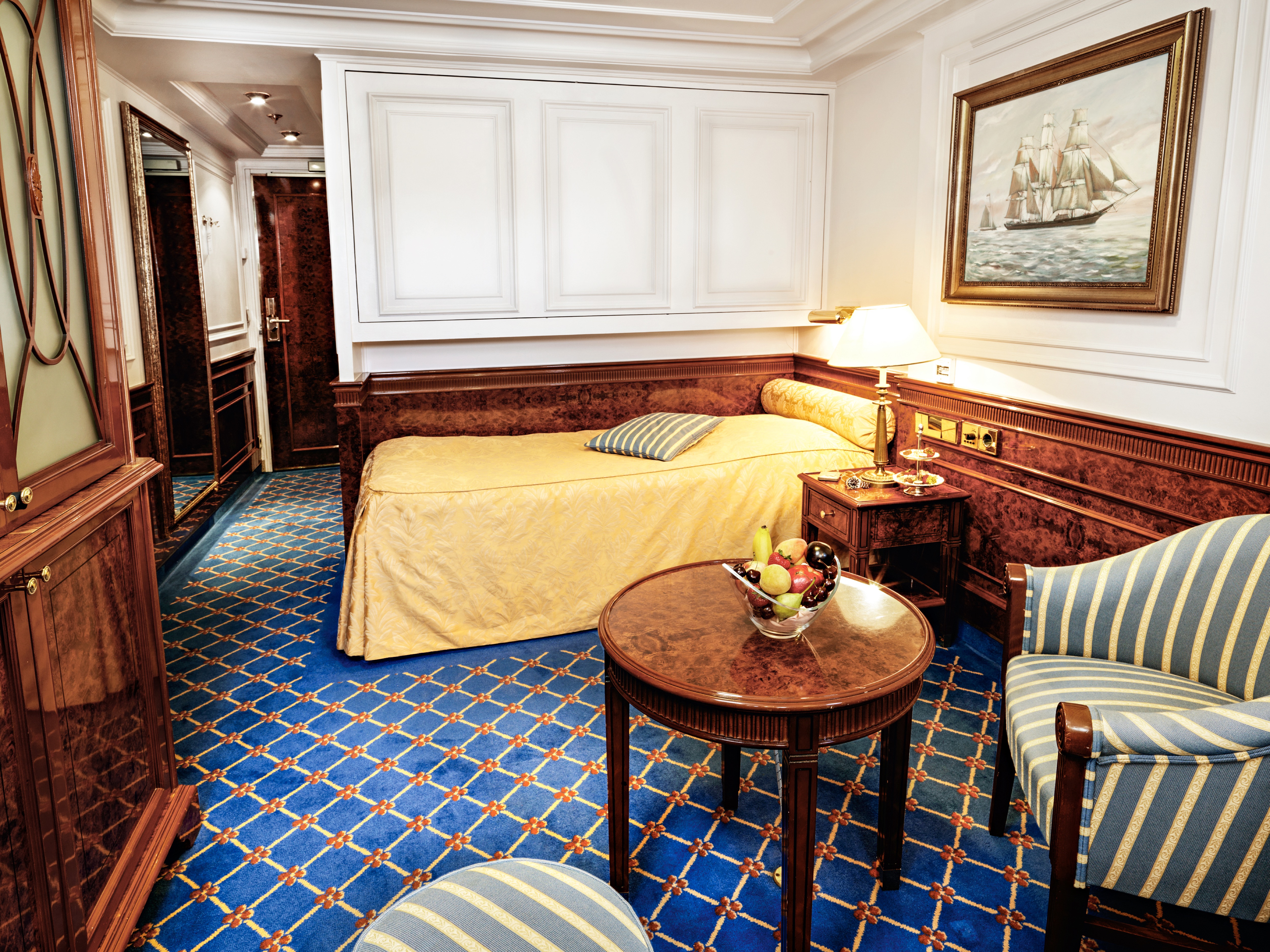
Guarantee Cabins
Guaranteed stateroom: Space is limited. Allocations are at SEA CLOUD CRUISES’ discretion starting in Category F. You will receive your exact stateroom number when arriving on board.
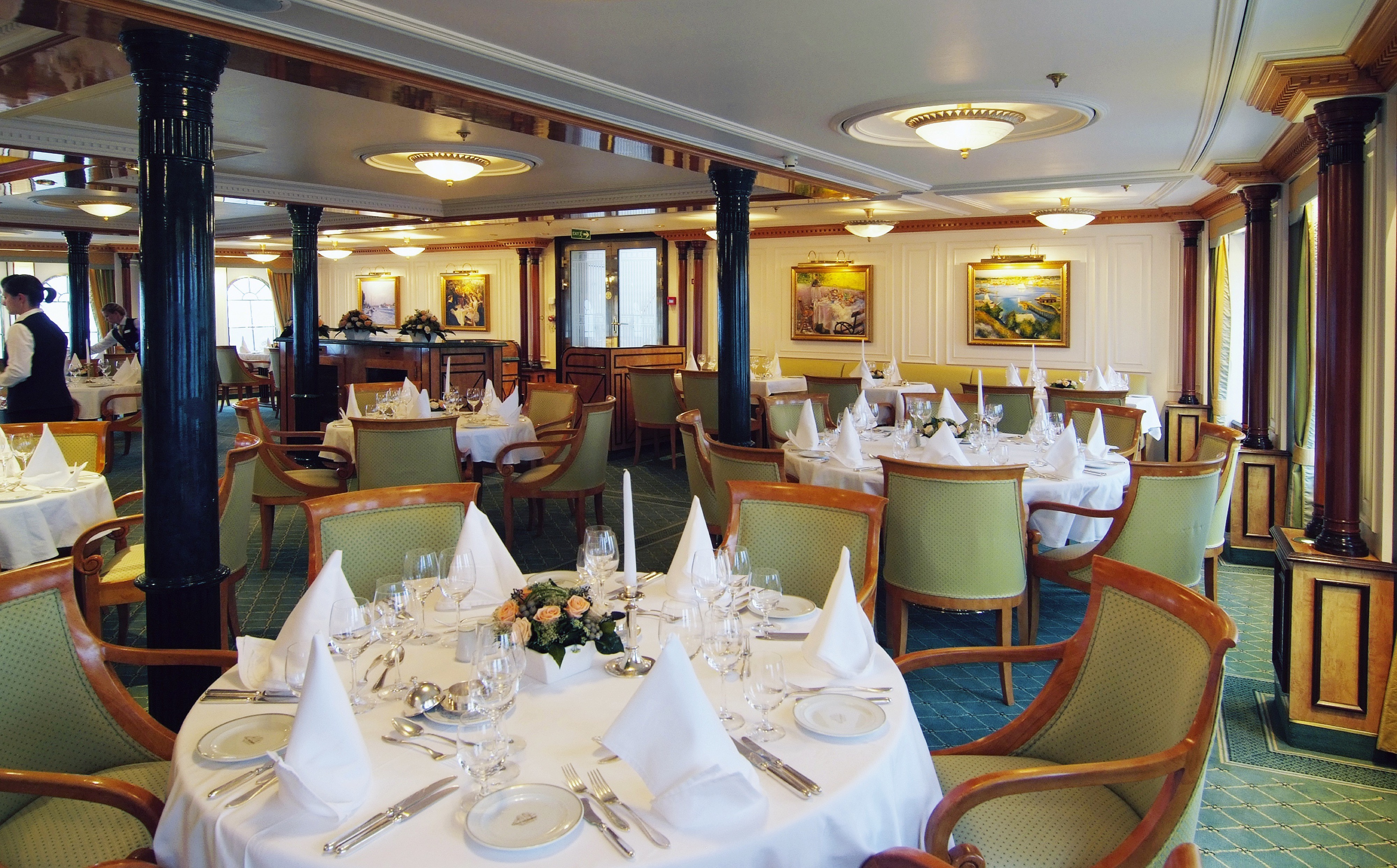
Restaurant
Meals are served on our ships in one seating. Service times can be found in the daily program on board. Please kindly note that reservations are not possible.
Our top-quality wines from well-known vineyards are often locally sourced. Our sommelier carefully selects each wine for every season and sailing destination. Wines are paired with lunch and dinner menus. In addition, you are always free to select your favourite wine from the menu.
A small breakfast with pastries and fruits is offered to early and late risers onboard the SEA CLOUDs. On board the SEA CLOUD II, a small breakfast is available at the Lido Bar. The main breakfast buffet is provided in the restaurant. Lunch is served as a buffet on the lido deck or in the restaurant. In the afternoon, coffee and tea are served, accompanied by some sweet treats and sandwiches. Dinner is a four-course menu with entrees to choose including a vegetarian option. Our executive chef will prepare an exclusive five-course meal for the gala dinner. A late-night snack nicely rounds up the evening’s culinary delights.

Lido Deck
You will find a dining area and Lido Bar on the Lido Deck.
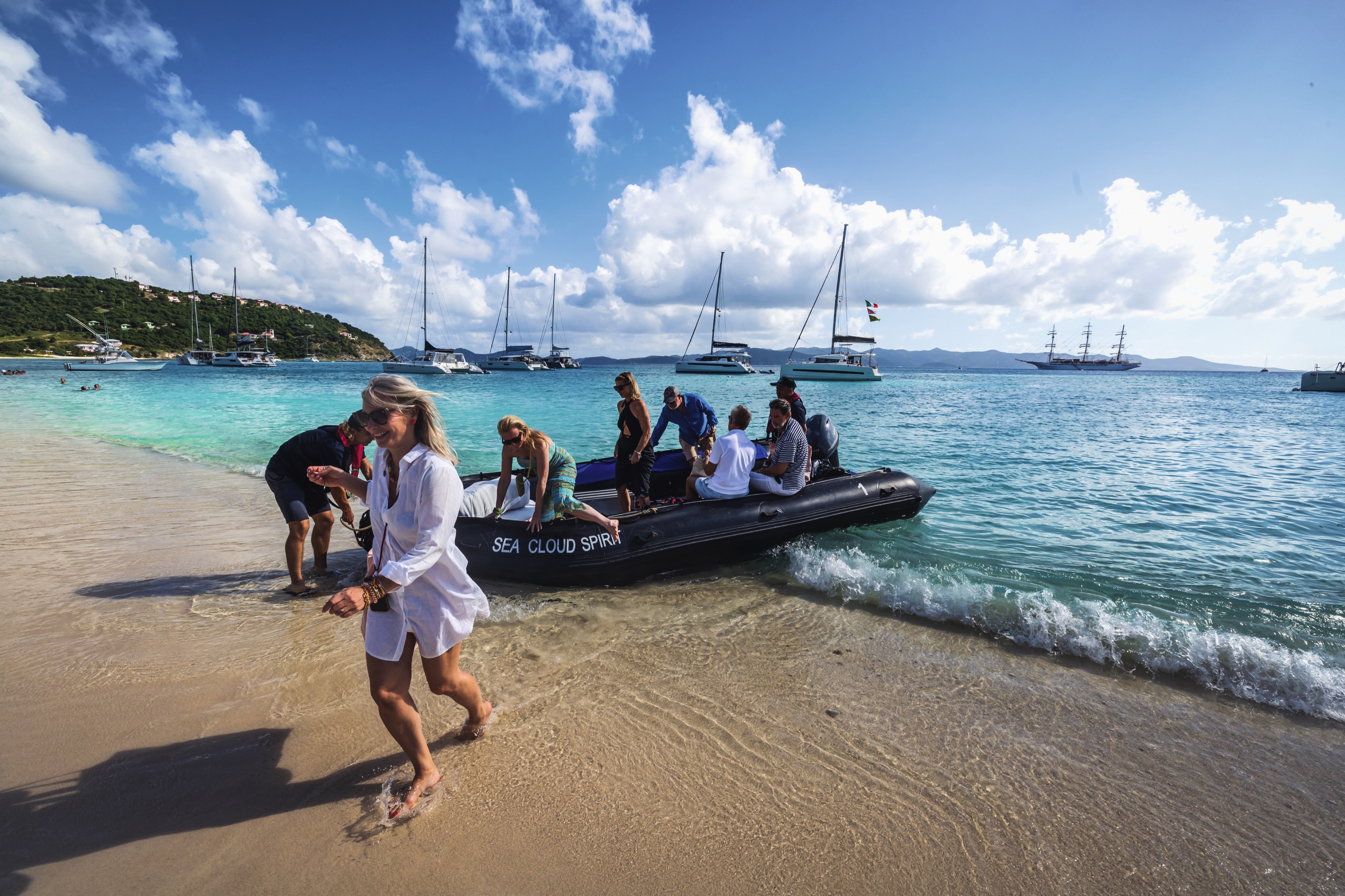
Zodiacs
Zodiacs are small motor-driven rigid-hull inflatable boats with a capacity of approximately 8 to 10 guests, primarily used for beach landings on our cruises or our photo safaris.

Watersports
Water sport activities are offered from the gangway on the marina platform.
We do have snorkelling equipment in different sizes on board, stand-up paddle bards for beach landings and a towable tube from the gangway.
All water sport activities are included and subject to weather and Captains permission.
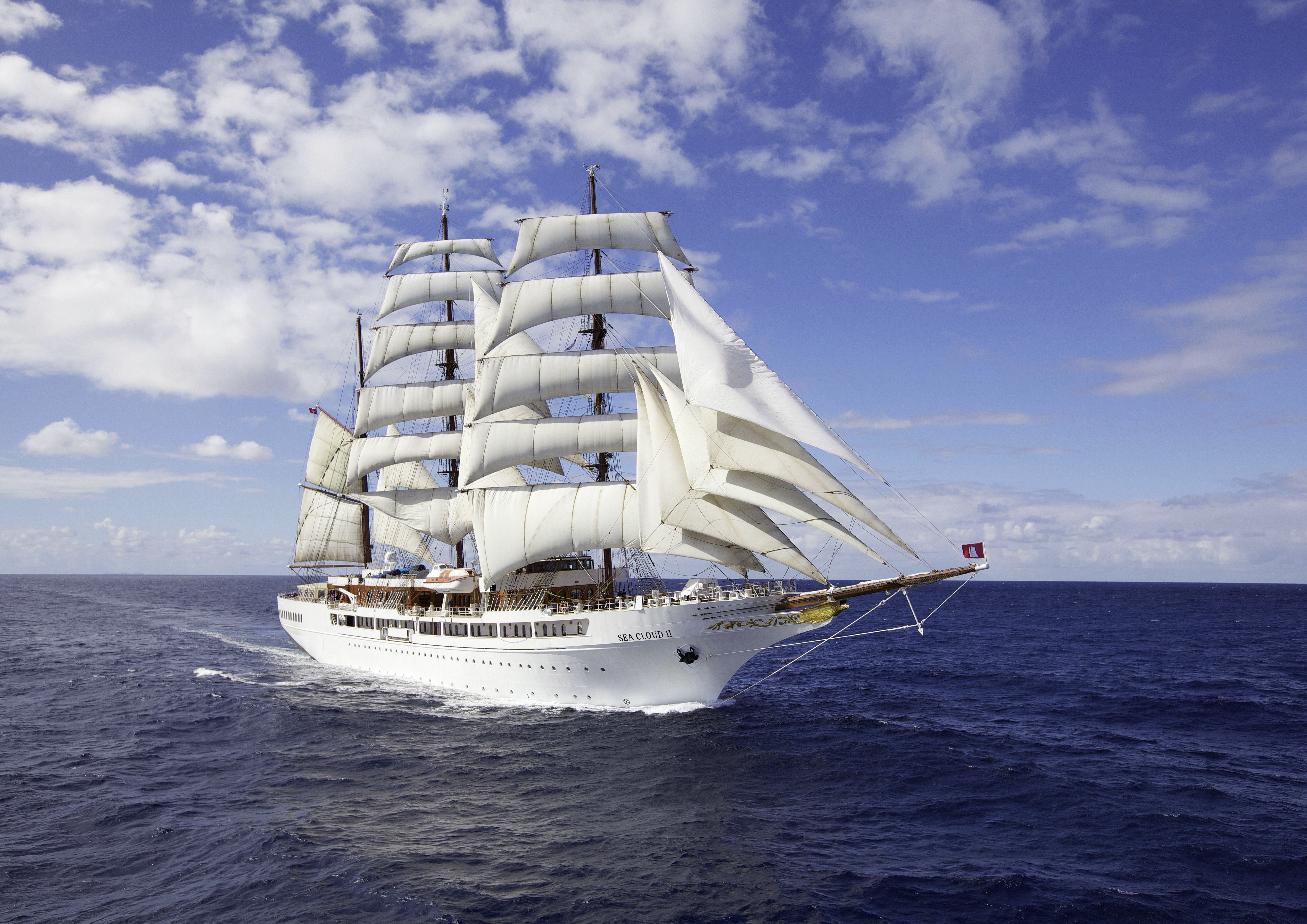
Excursions
All our shore excursions are shown on the itinerary pages of our brochure. 4 weeks prior to departure you will receive detailed information on shore excursions with your travel documents. The shore excursion booklet also includes the order form to pre-book your excursions. On board the Cruise Director will be able to provide further details during a lecture. We do recommend pre-booking prior to embarkation to secure your spot. All excursions will be charged to your cabin account on board.
You are free to join an organised shore excursion, stay on board or make individual arrangements. You will find times for tender or to be back on board in your daily program and at the gangway.
Please remember to bring comfortable footwear, a light jacket/windbreaker, as well as sunscreen where appropriate.
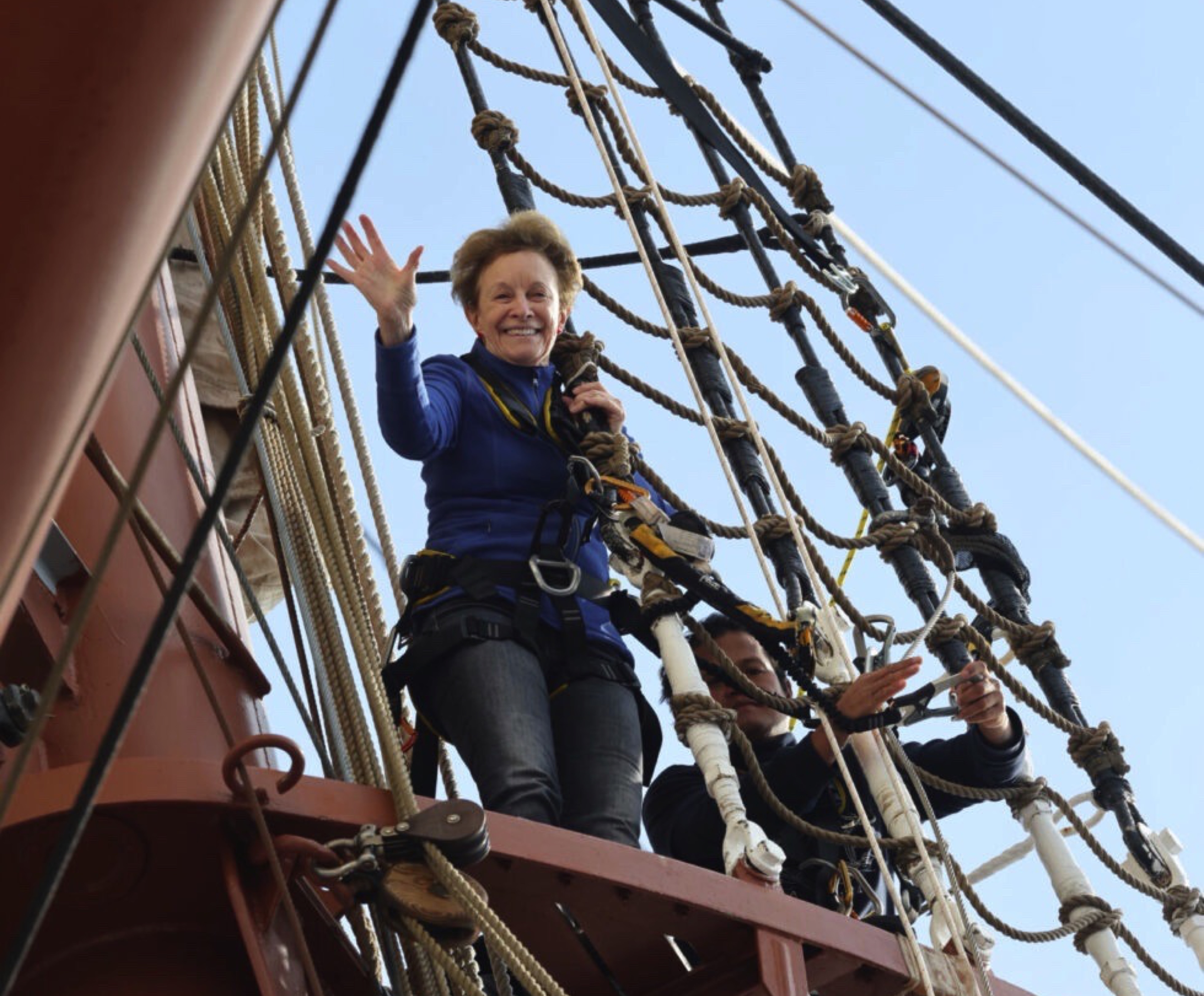
Rigg Climbing
Join us for some rigg climbing
One of the most captivating experiences onboard the SEA CLOUD windjammer is watching the crew climb into the rigging to set the sails by hand. Now, you can share a piece of this adventure yourself and – if your fitness allows – climb up to the first platform!
Our SEA CLOUDs are the only cruise ships in the world that are traditionally sailed by hand. Here, nothing happens at the push of a button: setting the sails follows centuries-old rituals, bringing the magic of sailing to life in a unique way. Now, you can experience this tradition up close! High up in the rigging, carried by the wind and with sweeping views over the sea, you’ll feel the majestic power of our tall ships even more intensely. Safely guided and equipped with state-of-the-art safety systems, you can climb up to the first platform, about 14 meters above the deck – an unforgettable moment for those seeking adventure!
A brief fitness check on board ensures that you feel completely comfortable and secure before you ascend. This includes: hanging from a bar for 10 seconds, balancing on one foot for 20 seconds and climbing stairs two at a time. Our experienced deckhands, specially trained for these activities, will guide you every step of the way so you always feel safe and well taken care of.
Embark on this unique adventure now – a once-in-a-lifetime moment that will leave you with a deep sense of joy and a touch of pride. Are you ready to experience the sea in all its splendour, high above the sails?
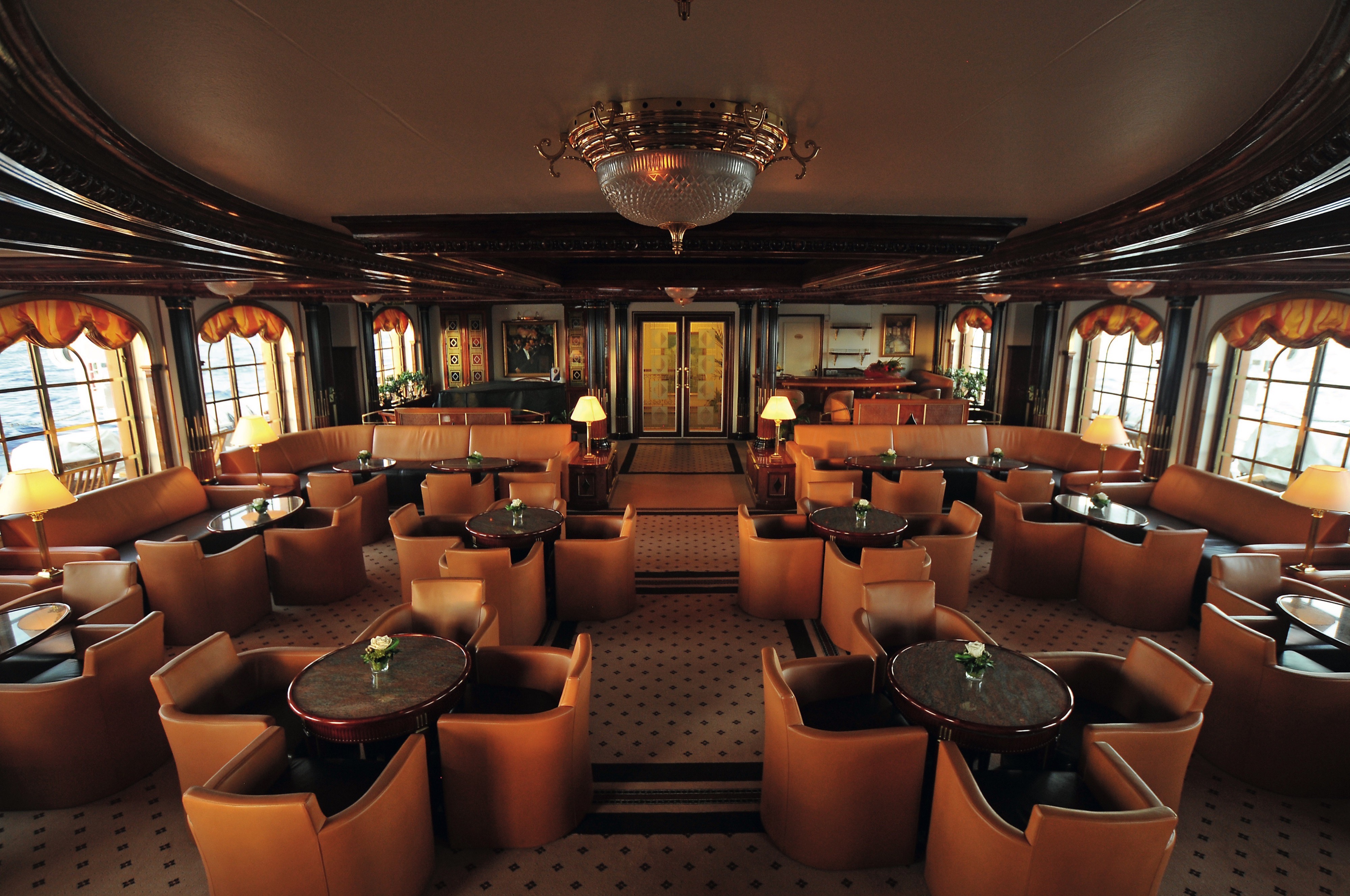
Lounge
The lounge is located on the Lido Deck (SEA CLOUD II & SEA CLOUD SPIRIT) and is always open. This is where all lectures take place and on select sailings concerts on the Steinway grand piano (SEA CLOUD II and SEA CLOUD SPIRIT). Enjoy a selection of games or just an afternoon snack.
The Lounge Bar is open daily from 11:00 am. All drinks, alcoholic and non-alcoholic are included, premium drink are at an additional charge.
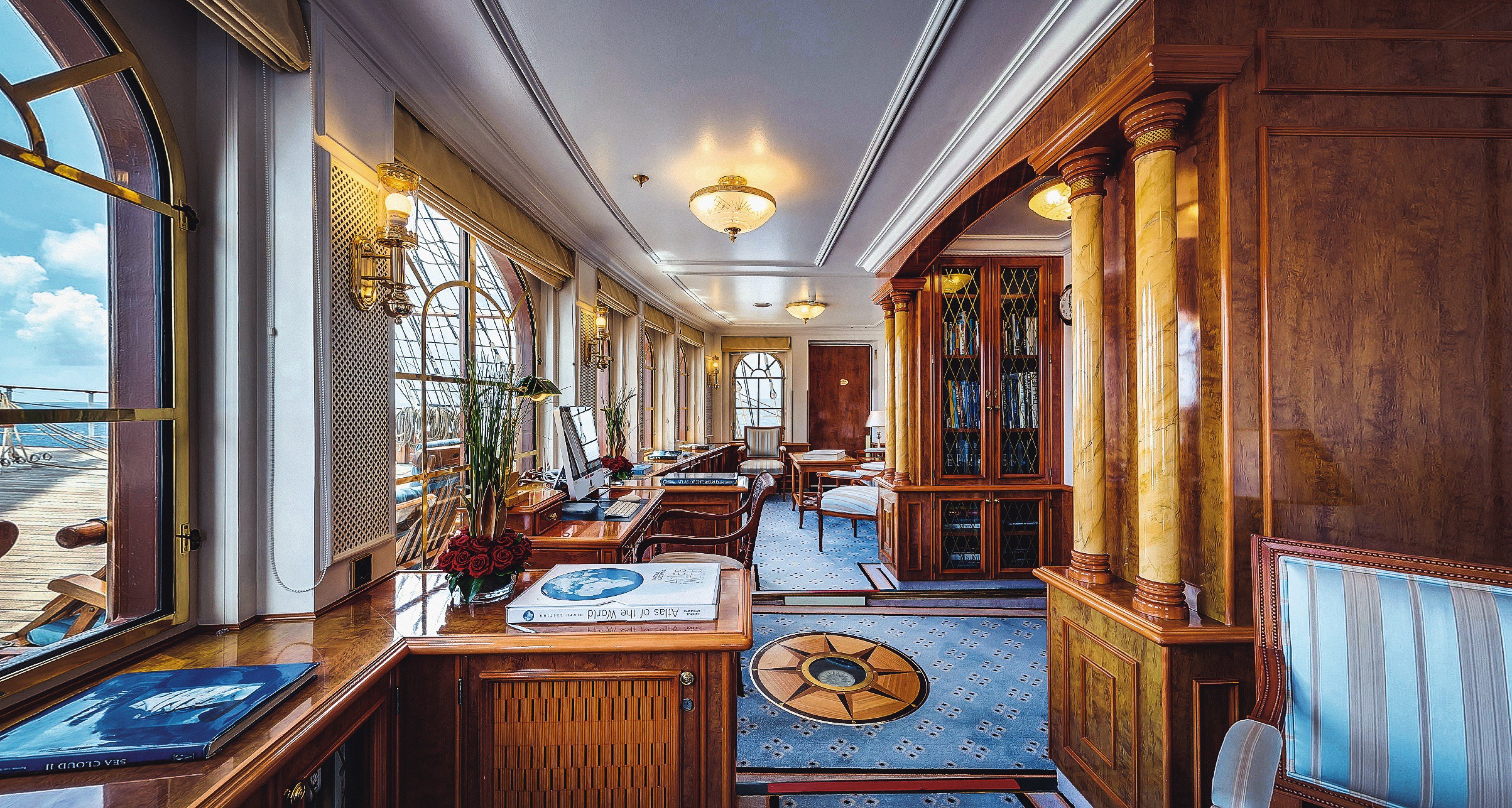
Library
Our beautiful library offers a variety of English books, popular board games and DVDs (SEA CLOUD II only). You are welcome to take the books to your cabin during your sailing and return before the end of your cruise.

Lido Deck with Bar
The Lido is open daily from 11:00 am. All drinks, alcoholic and non-alcoholic are included, premium drink are at an additional charge.
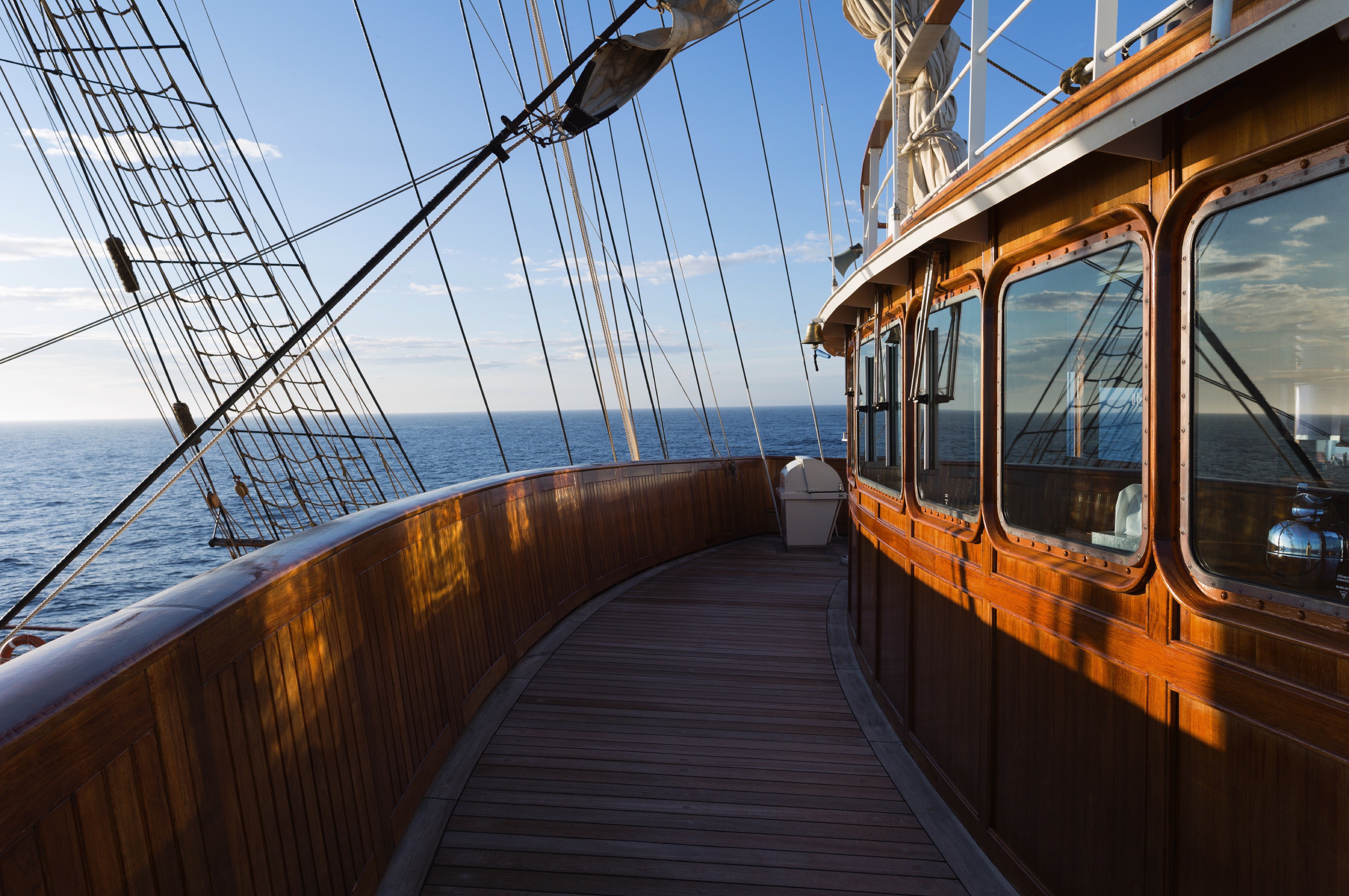
Bridge
The bridge area can be visited during the day and/or at specified times, subject to captain’s approval. The bridge is closed during manoeuvring operations and night sailing.
Boutique
The boutique on our yachts offers accessories, clothes, and gifts. Opening hours vary. You will find the exact information in the daily program and on the public boards. Feel free to contact the reception with any questions or requests outside of opening hours.
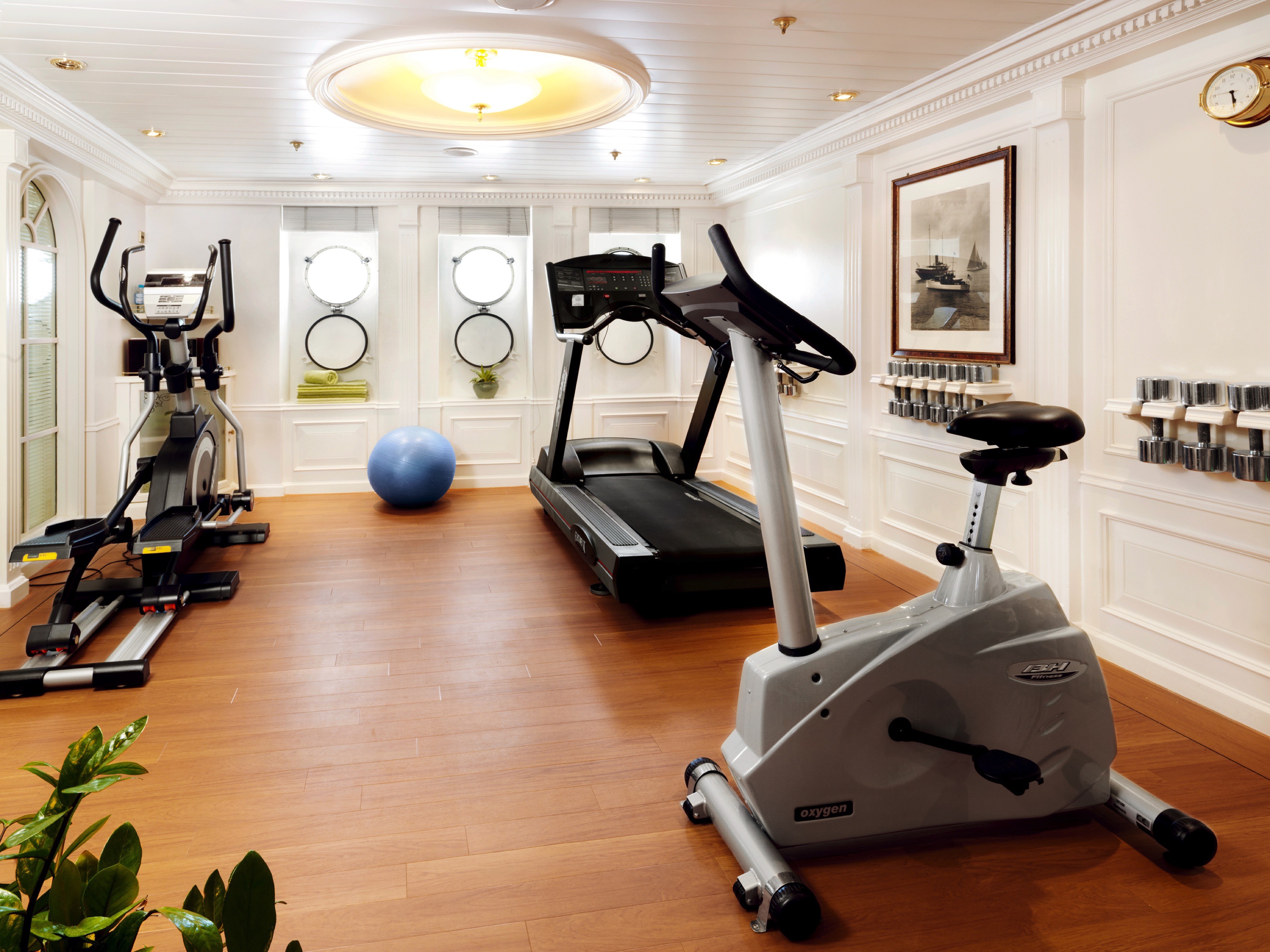
Fitness and Sport
SEA CLOUD II has a fitness area on the cabin deck. The gym is open during the day and is equipped with a step machine, a bike, a treadmill, and a rowing machine.

Massage & Cosmetics
On SEA CLOUD II we offer massages and beauty treatments at an additional fee We do have a sauna on the cabin deck, which is heated upon request. Please contact the reception.
Special Dietary Requirements
Please inform us prior to your cruise if you have any allergies, intolerances, or other special dietary restrictions. We will try to accommodate your needs as far as possible.
Dress Code
During the day, we recommend casual chic, yachting clothes. The evenings are casual elegant. Please refrain from wearing swimwear during lunch and/or shorts at dinner. For the Captain’s Dinner (once or twice depending on lengths of the cruise), we recommend elegant cocktail attire, a suit or ensemble for the gentleman and matching dress for the lady. We additionally suggest bringing non-slippery boat shoes.
Disabled Access
Our windjammers, SEA CLOUD, SEA CLOUD II and SEA CLOUD SPIRIT, are not barrier-free and, therefore, unsuitable for wheelchair users. Please contact our reservations directly for details.
There are no elevators on the SEA CLOUD and SEA CLOUD II, only staircases. SEA CLOUD SPIRIT is equipped with an elevator. You will access and depart the ship via the onboard gangway, which is not always level. Depending on weather conditions, access might be steep. The tenders or zodiacs service is done via the gangway. Please contact us prior to cruise if you have any questions regarding accessibility. If you need specific medical arrangements, please contact us in advance.
Smoking Policy
Smoking is permitted only on the lido deck outside of mealtimes. We kindly request that smokers take the other passengers into consideration. Smoking is always prohibited in covered areas on the lido deck, of the spanker deck (SEA CLOUD), on the blue lagoon (SEA CLOUD II), on the sun deck and on the verandah (SEA CLOUD SPIRIT).
Internet Access
Each of our yachts is equipped with Starlink satellite internet. All three ships offer WI-FI access in the public areas and in the staterooms. You can use your own laptop to access the Internet with an access code (WI-FI). Data volume of 10 GB is free of charge; additional data volume can be obtained from the reception desk at a charge. Continuous reception cannot be guaranteed; in certain sailing areas or due to the set course, interruptions to network coverage might be experienced. The WI-FI connection on a ship is not comparable to the usual reception on land.
On board, a laptop that is located in the lounge (SEA CLOUD) or in the library (SEA CLOUD II & SEA CLOUD SPIRIT) can be used for e-mail use on board. The SEA CLOUDs have their own on-board email addresses as follows:
SEA CLOUD: seacloud@seacloud.com
SEA CLOUD II: seacloud2@seacloud.com
SEA CLOUD SPIRIT: passenger@scs.seacloud.com
Please advise anyone you give the above email address to not send messages with attachments. Please put your name and cabin number in the subject line to ensure that the reception can forward any correspondence to you. They will hand you a printout of the e-mail.
Incoming and outgoing e-mails up to 50 KB in size can be received or send free of charge. However, files larger than 50 KB per message are automatically rejected by the system.
Due to limited network availabilities at sea, cell phones use is limited. The SEA CLOUDs are equipped with Starlink that ensures WIFI connection. Phone numbers to reach the ship can be found in your travel documents and on board.
Laundry Services
Laundry services on board are limited to washing and ironing. There is no dry cleaning available. You will find a price list for the overnight laundry and ironing service in your closet. For guests who have booked a suite in category A-C (SEA CLOUD) or category A+B (SEA CLOUD II & SEA CLOUD SPIRIT) the laundry service complimentary. For safety reasons, passengers are not permitted to iron in their cabins.
Children on Board
Children are welcome on our ships, but please keep in mind there is no daycare or special entertainment for children on board our ships.
Sustainability & Low Impact Tourism
OUR CONTRIBUTION TO ECO-FRIENDLY TRAVEL
We approach the people and their cultures with respect in all the regions we visit, travelling mindfully through the local environment. By doing this, we can bring our guests closer – in the truest sense of the word – to these places, and what makes each one special.
THE WINDJAMMER EXPERIENCE
For you and us alike, the key attraction of our trips is the chance to sail on the open seas.
We therefore take every opportunity to set sail and be propelled by the sheer power of the wind. That is why the captain will sometimes change the route if the weather requires it. On board our SEA CLOUD tall ships, you’ll experience the elements, as many of the day-to-day activities take place outside.
HAVING AS LITTLE IMPACT AS POSSIBLE
When we do have to start the engines, we utilise low-sulphur marine diesel on all three of our windjammers.
For us, this is standard practice. Even the SEA CLOUD, our very first windjammer, was equipped with this technology right from the start. Our motto: to minimise our impact on the environment yet still make a profound and positive impression on those around us.
A SUSTAINABLE APPROACH TO LIFE ON-BOARD
Avoiding plastic, reducing water usage and protecting the environment.
These are the factors that guide us in the day to day operation of our ships and our ongoing development of eco-friendly alternatives. To cite just one example, our reusable drinks bottles are not only easy on the eye, but also easy on the environment.
QUALITY, NOT QUANTITY
Our ‘small but perfectly formed’ windjammers are able to visit smaller ports, away from the busy routes frequented by large cruise liners.
With a maximum of 64 to 136 passengers, we’re always welcomed in those locations thanks to our approach of visiting local communities rather than overwhelming them. Needless to say, our itineraries also include some classic destinations, though we usually visit these only when the mega-liners have moved on.
BOOSTING THE LOCAL ECONOMY
Procuring supplies locally, working with local, smaller-scale agencies and paying fair prices.
By taking this approach, we see ourselves as a partner for our local service providers, with whom we’ve built relationships based on trust over many years. After all, we want our voyages to benefit both our guests and the communities we visit around the world.
AUTHENTIC CUISINE
Our menus are always a true reflection of the regional cuisine.
This is because our chefs enjoy buying exotic spices, local specialities and freshly caught fish from local markets to bring you – even in a culinary sense – closer to the places we visit.
A MEMBER OF THE FUTOURIS NETWORK
Heading into the future with Futouris.
Preserving the natural and cultural heritage of our world and shaping the future of tourism in a sustainable way is what Futouris stands for. Members of the network are working globally to improve people’s living conditions, preserve biodiversity and protect the environment and climate.
Medical Facilities
All three ships have a clinic and a ship’s doctor. Medical consultation hours can be found in the daily program. In case of an emergency, the doctor can be reached at any time by calling 911.
What's Included
Complimentary with your sailing:
- Welcome champagne in suite/stateroom
- Daily fresh fruit basket in suite/stateroom
- All meals including nightly 4-course menu and a 5-course gala dinner
- Fine wines from renowned winemakers and beer for lunch and dinner
- All non-alcoholic coffee and tea specialties
- All soft drinks
- Welcome and farewell cocktail
- Bottled water on excursions
- Gratuities and port fees
- Curated moments
- Beach barbecues in select destinations
- Marina platform with use of water sports equipment such as snorkel gear, stand-up paddleboards, and towable tube (weather permitting)
- Laundry service in suites

Sun Deck
- Captain
- Bridge

Lido Deck
- Lounge
- Lido Bar
- Lido Deck
- Library
- Cat. A Owner’s Suites

Promenade Deck
- Restaurant
- Boutique
- Purser
- Reception
- Junior Suites
- Grand Staterooms

Cabin Deck
- Fitness Area
- Massage and Cosmetics
- Hospital
- Swim Platform
- Deluxe Stateroom
- Stateroom (Upper/Lower-bed Cabins)
